FY2023 Annual Report
Theory of Quantum Matter Unit
Professor Nic Shannon

Abstract
FY2023 was the year in which the TQM Unit was finally able to return to the patterns of work it enjoyed before the COVID pandemic, with conferences, seminars and other scientific exchanges taking place almost exclusively "in person". It was also a year memorable year for babies, with three born to present members of the Unit, and another three to former members of the Unit.
Scientifically, the Unit also returned to pre-pandemic norms for productivity, publishing eight papers, including one in Physical Review Letters, a Letter in Physical Review B, and regular Article in Physical Review B which was singled out as an Editor's choice. Notable results included a proposal for simulating gravitational waves using cold atoms, further developments of variational algorithms for quantum computers, and finite-temperature calculations for a Kitaev magnet made using matrix product states.
Parental leave, and some unfortunately-timed cases of COVID, limited the participation of senior group members in international events. None the less Unit members gave a total 7 invited and 14 contributed talks in FY 2023, as well as 2 research seminars. The Unit was also delighted to welcome 13 visitors to OIST, including extended visits by Prof. Robert Joynt (UW-Madison, USA), Dr Yuki Amari (Keio, Japan), and former OIST PhD students, Prof. Rico Pohle (Keio, Japan) and Dr Kim Remund (National Yang Ming Chiao Tung University, Taiwan). The Unit hosted 15 resesarch seminars in FY 2023, all of them in person.
The Unit welcomed three new members in FY 2023, Dr Ayushi Singharia and Dr Prany Patil, who joined as postdocs in December 2023, and Ms Shino Takagi, who became the Unit's RUA in March 2024. Sadly, Ms Chika Sparacio left the unit in May 2023. The Unit is deeply endebted to Ms Shiho Chinen, who took care of its administrative needs from June 2023 until the end of the financial year.
1. Staff
- Dr. Matthias Gohlke, Staff Scientist
- Dr. Tokuro Shimokawa, Staff Scientist
- Dr. Pranay Patil, Postdoctoral Scholar
- Dr. Geet Rakala, Postdoctoral Scholar
- Dr. Ayushi Singhania, Postdoctoral Scholar
- Dr. Jonas Sonnenschein, Postdoctoral Scholar
- Mr. Jiahui Bao, PhD Student
- Ms. Leilee Chojnacki, PhD Student
- Mr. Soshi Mizutani, PhD Student (non-study leave)
- Dr. Kimberly Remund, Junior Research Fellow
- Mr. Snigdh Sabharwal, PhD Student
- Ms. Ananya Samanta, PhD Student
- Ms. Shiho Chinen, Research Unit Administrator
- Ms. Chika Sparacio, Research Unit Administrator
- Ms. Shino Takagi, Research Unit Administrator
2. Collaborations
2.1 Extended Quantum Spin Liquid with Spinon-like Excitations in an Anisotropic Kitaev-Gamma Model
- Type of collaboration: Joint research
- Researchers:
- Dr. Matthias Gohlke, OIST
- MSc. Jose Carlos Pelayo, OIST
- Associate Prof. Takafumi Suzuki, University of Hyogo
2.2 Thermal pure matrix product state in two dimensions
- Type of collaboration: Joint research
- Researchers:
- Dr. Matthias Gohlke, OIST
- MSc. Atsushi Iwaki, The University of Tokyo
- Prof. Chisa Hotta, The University of Tokyo
2.3 Thermal pure matrix product state in two dimensions
- Type of collaboration: Joint research
- Researchers:
- Dr. Matthias Gohlke, OIST
- Dr. Alberto Corticelli, MPI-PKS
- Prof. Roderich Moessner, MPI-PKS
- Dr. Paul McClarty, MPI-PKS / CNRS
- Dr. Alexander Mook, Univeristy of Mainz
2.4 Magnon Spectra of Cuprate Materials beyond Spin Wave Theory
- Type of collaboration: Joint research
- Researchers:
- Mr. Jiahui Bao, OIST
- Dr. Matthias Gohlke, OIST
- Prof. Jeffrey G. Rau, University of Windsor
- Prof. Nic Shannon, OIST
2.5 Thermal Expansion Anomalies in Spinels: CdCr204 and Beyond
- Type of collaboration: Joint research
- Researchers:
- Mrs. Ananya Samanta, OIST
- Dr. Geet Rakala, OIST
- Prof. Han Yan, The University of Tokyo
- Prof. Karlo Penc, HUN-REN Wigner Research Centre for Physics
- Prof. Nic Shannon, OIST
2.6 Gravitational wave analogues in spin nematics and spinor condensates
- Type of collaboration: Joint research
- Researchers:
- Mrs. Leilee Chojnacki, OIST
- Prof. Rico Pohle, The University of Tokyo / Keio University
- Prof. Han Yan, The University of Tokyo
- Prof. Yutaka Akagi, The University of Tokyo
- Prof. Nic Shannon, OIST
2.7 Multipartite entanglement in 2D triangular lattice antiferromagnets
- Type of collaboration: Joint research
- Researchers:
- Dr. Tokuro Shimokawa, OIST
- Mr. Snigdh Sabharwal, OIST
- Prof. Nic Shannon, OIST
2.9 Nature of quantum spin liquid state in bilayer-breathing kagome magnets
- Type of collaboration: Joint research
- Researchers:
- Dr. Tokuro Shimokawa, OIST
- Dr. Jonas Sonnenschein, OIST
- Prof. Rico Pohle, The University of Tokyo / Keio University
- Prof. Nic Shannon, OIST
2.9 Nature of valence bond crystal state in spatially-distorted honeycomb lattice antiferromagnets
- Type of collaboration: Joint research
- Researchers:
- Dr. Tokuro Shimokawa, OIST
- Mr. Sho Inoue, Osaka University
- Prof. Masayuki Hagiwara, Osaka University
2.10 Multiple-q states in classical frustrated honeycomb-lattice magnets
- Type of collaboration: Joint research
- Researchers:
- Dr. Tokuro Shimokawa, OIST
- Prof. Rico Pohle, The University of Tokyo / Keio University
2.11 Multiple-q states in classical frustrated honeycomb-lattice magnets
- Type of collaboration: Joint research
- Researchers:
- Dr. Jonas Sonnenschein, OIST
- Dr. Atanu Maity, Wuerzburg University
- Prof. Yasir Iqbal, Indian Institute of Technology Madras
2.12 Witnessing Disorder in a Quantum Spin Liquid
- Type of collaboration: Joint research
- Researchers:
- Mr. Snigdh Sabharwal, OIST
- Dr. Tokuro Shimokawa, OIST
- Prof. Nic Shannon, OIST
2.13 Nature of spin nematic state in the square lattice Iridates
- Type of collaboration: Joint research
- Researchers:
- Mr. Jiahui Bao, OIST
- Dr. Matthias Gohlke, OIST
- Prof. Karlo Penc, HUN-REN Wigner Research Centre for Physics
- Prof. Nic Shannon, OIST
2.14 Z_2 spin liquid in Rydberg atom arrays
- Type of Collaboration: Joint Research
- Researchers:
- Prof. Owen Benton, Queen Mary University
- Dr. Pranay Patil, OIST
2.15 Single ion anisotropy effect in frustrated Heisenberg model on honeycombe lattice
- Type of Collaboration: Joint Research
- Researchers:
- Dr. Ayushi Singhania, OIST
- Dr. Sumiran Pujari, IIT Bombay, India
2.16 Dzyaloshinskii Moriya interaction effects in Kitaev Heisenberg model
- Type of Collaboration: Joint Research
- Researchers:
- Mr. Manodip Routh. S.N.B.N.C.B.S
- Dr. Ayushi Singhania, OIST
- Dr. Satoshi Nishimoto, IFW Dresden
- Prof. Manoranjan Kumar, S.N.B.N.C.B.S
2.17 Phase transitions in quantum control landscapes
- Type Joint Research
- Researchers:
- Mr. Nicolo Beato (MPIPKS)
- Dr. Marin Bukos (MPIPKS)
- Dr. Pranay Patil (OIST)
3. Activities and Findings
3.1 Can AI solve problems that people can't ?
Much has been made of AI's potential to revolutionize the workplace, by making machines autonomous, and replacing humans in language or image-based tasks. But what can AI contribute to questions at the frontiers of science where, by definition, there is no previous answer to imitate ? In previous work, we have shown how machine learning can be capable of generating equations characterising novel phases of matter [Greitmann et al, Phys. Rev. B 100, 174408 (2019)]. However the problems considered was one which human researchers had also been able to solve, albeit through many year's effort [Taillefumier et al., 7 041057 (2017)]. How do machines fare in problems that humans have not been able to solve ?
We have examined how AI contributed to the solution of a difficult problem in frustrated magnetism: the phase transition from a spin liquid described by a tensor gauge theory into a previously unknown form of magnetic order. This problem, which had defied conventional numerical simulation, was solved through a generative use of support vector machine (SVM), without prior training on related problems. However, neither the contributions of the SVM, nor that of the human researchers, proved decisive by themselves. Rather, success followed from a process resembling a collaboration between man and machine. We argue that this kind of "collaboration" may become the norm, especially in research involving large sets of data.
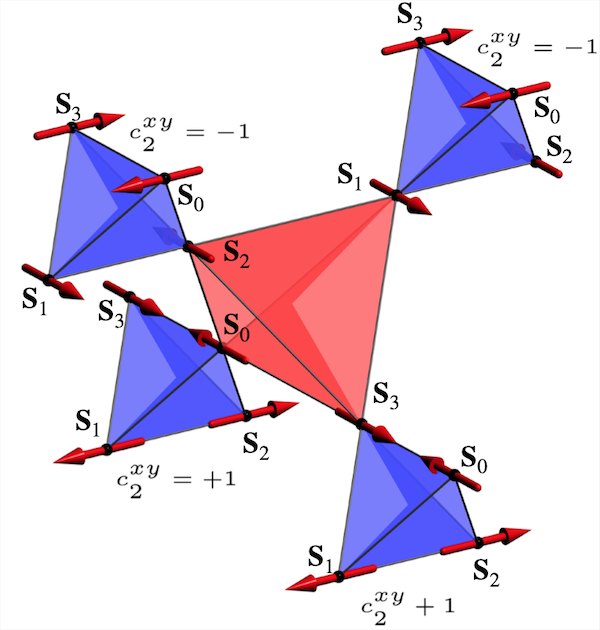
Complex nematic state on breathing pyrochlore lattice found through "human-machine" collaboration
This work is described in the preprint "Human-machine collaboration: ordering mechanism of rank−2 spin liquid on breathing pyrochlore lattice", Nicolas Sadoune, Ke Liu, Han Yan, Ludovic D.C. Jaubert, Nic Shannon, and Lode Pollet, arXiv:2402.10658.
3.2 How can we simulate gravitational waves here on earth ?

3.3 Thermal pure matrix product state in two dimensions: tracking thermal equilibrium from paramagnet down to the Kitaev honeycomb spin liquid state
Finite temperature properties of quantum many body systems with strongly competing interactions in two spatial dimension are generically difficult to study. Characterizing a thermal quantum state is an on-going fundamental challenge since it is often a matter of quantum and classical correlations. The different representations of a thermal quantum state can categorized by their purity, in particular there exist two limits: the Gibbs state is represents a mixture over exponentially many states and is of low purity, while the thermal pure quantum (TPQ) state represents a thermal state within one pure wave function. Previously, the Gibbs state with smallest entanglement has been shown to conform to the thermal area law suitable for tensor network representation. Contrarily, the TPQ state with its volume law entanglement is difficult to study by area-law structured matrix product state (MPS). However, our specific ansatz called TPQ-MPS making use of the small entanglement bath can host a stable entanglement structure over the entire system. The figure shows the TPQ-MPS ansatz for the honeycomb lattice.
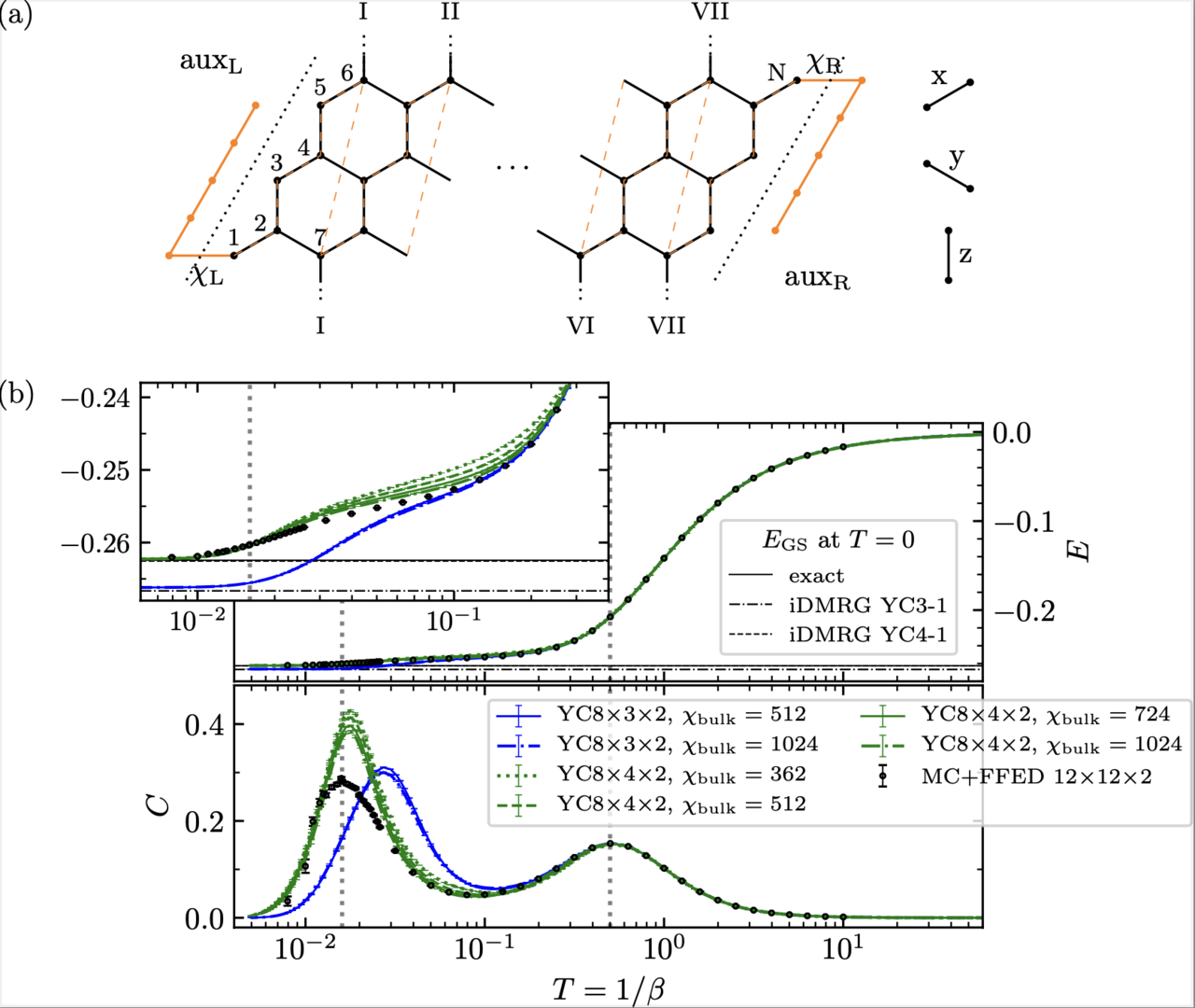
Figure: (a) Illustration of the TPQ-MPS structure for the honeycomb lattice. Black circles and lines resemble the physical sites and the lattice, while the auxiliary sites acting as an entanglement bath are highlighted in orange. (b) Numerical results for the Kitaev honeycomb model including a comparison to a reference method (MC+FFED).
In this work, we illustrate that the MPS framework provides a pure quantum many-body state representation for the thermal equilibrium in two spatial dimensions throughout the whole temperature range. Our test case is the famous Kitaev honeycomb model with characteristic features at finite temperature: two crossover signaled by broad specific heat peaks originating from the fractionalization of the spin-1/2 degrees of freedom into Z2 fluxes and itinerant Majorana fermions at high temperature and the approach of the flux-free state at low temperature. Starting from the random high temperature state, the system reaches the highly entangled fractionalized spin liquid ground state. The truncation process of TPQ-MPS efficiently discards the basis of the high temperature part and attains the highly entangled description of the topologically ordered ground state.
This work was published as "Thermal pure matrix product state in two dimensions: tracking thermal equilibrium from paramagnet down to the Kitaev honeycomb spin liquid state", Matthias Gohlke, Atsushi Iwaki, Chisa Hotta, SciPost Phys. 15, 206 (2023).
3.4 Quantum spin liquids on the diamond lattice
Quantum spin liquids were traditionally described by the absence of a dipolar spin moment which in conventional magnets yields an order parameter. This lack of a suitable order parameter leads to the problem that Landau's theory of phase transition cannot be employed to classify these exotic phases of matter. Rather than using the absence of something as the defining property in modern condensed matter physics quantum spin liquids are thought of as phase of matter which exhibit emergent gauge fields and fractionalized quasi particles called spinons as their low-lying excitations. Extending the conventional symmetry group by these emergent gauge fields leads to the concept of projective symmetry groups or in short PSG. By using these PSG, we are in a position to extent Landau's framework and apply it to classify these unconventional quantum states. A lot of effort has been put into the study of quantum spin liquids in two dimensions. Yet very often one has to rely on mean-field approximations which not always turn out to be the correct assumption, especially in low dimensions. This is problem is concomitant to the emergence of continuous compact gauge fields which give rise to low lying gapless excitations. It then becomes crucial for the stability of a quantum spin liquid candidate to break the initial SU(2) gauge group to smaller subgroups. This breaking of the local symmetry is very similar to what is happening in a superconductor. However, the symmetry breaking is not caused by glueing two electrically charged electrons into a Cooper pair but by pairing of chargeless spinons.
In this work we study the diamond lattice; a three-dimensional frustrated lattice which may be the perfect setting for quantum spin liquid physics. We apply the PSG framework to classify and construct possible spin liquid candidates. We give a detailed description of how the emergent gauge group for different classes descents from SU(2) via U(1) down to Z2. After a self-consistency treatment, we employ variational Monte Carlo techniques to Gutzwiller project some of the most competitive states to discuss their characteristics in depth.
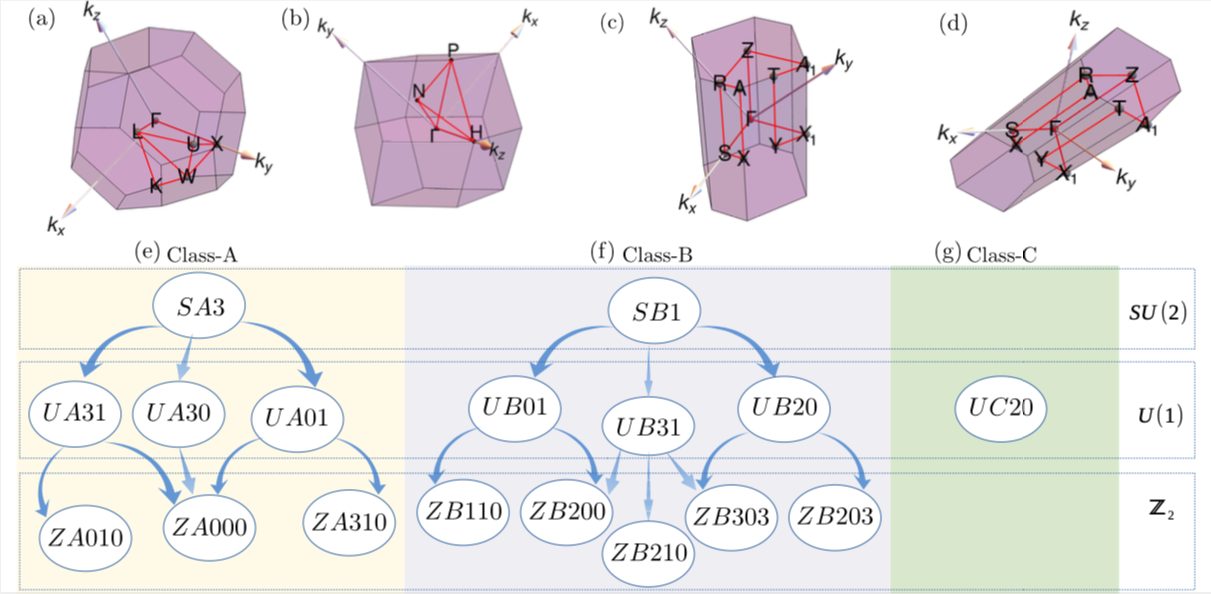
Illustration of (a) first Brillouin zone for class-A Ansätze, (b) the corresponding extended Brillouin zone. Illustration of the reduced Brillouin zones required for class-B (c) and class-C (d) Ansätze involving doubling and quadrupling of unit cells, respectively. The high-symmetry points marked have the following coordinates: (a), Γ = (0, 0, 0), X = (0, 2π, 0), U = (π/2, 2π, π/2), W = (π, 2π, 0), K = (3π/2, 3π/2, 0), and L = (π, π, π); (b), Γ = (0, 0, 0), H = (0, 0, 4π), N = (0, 2π, 2π) and P = (2π, 2π, 2π). In (c), the coordinates are Γ = (0, 0, 0), X = (π, π/4, −π/4), Z = (0, π, π), Y = (π/2, π/2, −π/2), S = (π, 0, 0), A1 = (0, 7π/4, π/4), T = (π/2, 3π/2, π/2), A = (π, 5π/4, 3π/4), R = (π, π, π), and X1 = (0, 3π/4, −3π/4).
In (d), Γ = (0, 0, 0), X = (π/2, π/8, −π/8), Z = (0, π, π), Y = (π/4, π/4, −π/4), S = (π/2, 0, 0), A1 = (0, 11π/8, 5π/8), T = (π/4, 5π/4, 3π/4), A = (π/2, 9π/8, 7π/8), R = (π/2, π, π), and X1 = (0, 3π/8, −3π/8). The family tree of spin liquids showing the interconnection between the parent and descendent states with different gauge groups for (e) class A, (f) class B, and (g) class C.
This work was published as "Quantum spin liquids on the diamond lattice", Aishwarya Chauhan, Atanu Maity, Chunxiao Liu, Jonas Sonnenschein, Francesco Ferrarri, and Yasir Iqbal, Phys. Rev. B 108, 134424 (2023).
3.5 Curie-law crossover in spin liquids
The Curie-Weiss law is widely used to estimate the strength of frustration in spin liquid materials. However, the Curie-Weiss law was originally derived as an estimate of magnetic correlations close to a mean-field phase transition, which – by definition – is absent in spin liquids. Consequently, certain materials were reported to exhibit deviations from the Curie-Weiss law, making a conclusive determination of their Curie-Weiss temperature challenging, especially when the high-temperature regime becomes inaccessible in experiments.
In this work, we show that the concept of a ”Curie-law crossover” (see Fig.1) provides an accurate description of the thermodynamic properties in spin liquids. We study the generic aspect of the Curie-law crossover by comparing a variety of frustrated spin models in two and three dimensions, using both classical Monte Carlo simulations and analytical Husimi tree calculations. While the Husimi tree approximation is quantitatively accurate for all temperatures, we find that the crossover is influenced by the structure of the frustrated unit cell, rather than its lattice dimension. As a complement to traditional methods, we propose an "easy-to-use" fitting Ansatz of the reduced susceptibility, χT, which can be used to estimate the Curie-Weiss temperature, even when the high-temperature regime is not accessible in experiment. Applications to spin liquid candidate materials such as the S=1 pyrochlore magnet NaCaNi2F7, the square-kagome material KCu6AlBiO4(SO4)5Cl, and the spiral-spin liquid FeCl3 are discussed.


This work was published as "Curie-law crossover in spin liquids", Rico Pohle and Ludovic D. C. Jaubert, Phys. Rev. B 108, 024411 (2023).
3.6 Identifying topologically critical band from pinch-point singularities in spectroscopy
In the evolving landscape of condensed matter physics, the study of topological materials—substances whose properties are protected by their topological characteristics—has become a frontier area of research. These materials exhibit unique and robust features that promise revolutionary applications in technology and quantum computing. One of the most intriguing aspects of topological materials is the presence of gapless points in their electronic, magnonic (related to magnetic excitations), and photonic band structures. Traditionally, identifying whether these gapless points are of topological nature requires extensive analysis of the system's microscopic details, such as lattice symmetries and Hamiltonian construction, which can be a formidable challenge. However, recent advancements suggest a simpler, more universal approach to uncovering the topological secrets of materials through spectroscopy.
In this paper, we introduce a novel and simpler method for identifying topological materials through the observation of pinch-point singularities in spectroscopic data. This approach does not require intricate knowledge of a system's microscopic details but instead focuses on universal patterns in the spectroscopic intensity distribution. These patterns, indicative of the system's topological nature, encode Berry curvature—a key metric of topological characteristics. Our method significantly eases the identification of topological phases across a variety of materials, from electronic to photonic systems, making it a groundbreaking tool for researchers seeking to explore and utilize the unique properties of topological materials.
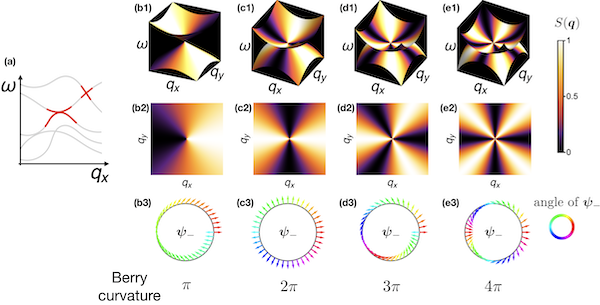
This work is described in the priprint "Identifying topologically critical band from pinch-point singularities in spectroscopy", Han Yan, arXiv:2304.02204.
3.7 Pinch points and half moons encode Berry curvature
In recent years, the discovery that the behavior of electron bands can be described using topological concepts has revolutionized condensed matter physics, offering fresh insights and prompting new lines of research. Such topological bands, first identified in materials known as "Chern Insulators" and subsequently in a variety of systems including graphene, have been pivotal in our understanding of topological insulators, semimetals, and superconductors. Extending beyond electrons, this framework has also found relevance in the study of magnetic insulators, where the excitation of magnon bands—waves of spin disturbances in magnets—carries topological indices, similar to their electronic counterparts. This advancement not only underscores the universality of topological phenomena across different material systems but also enriches our comprehension of magnetic materials and their exotic excitations.
Building on this foundational work, our research delves into the topological characteristics of magnon bands in frustrated magnets, as revealed through inelastic neutron scattering experiments. We focus on the intriguing appearance of "half moons," or crescent patterns, and "pinch points" in the scattering data, which we link to the underlying topological nature of magnon bands. Our analysis shows that these patterns signal the presence of Berry curvature, a fundamental property indicating the twist in the phase space of magnons, which plays a crucial role in their topological behavior. By studying how interactions among magnon bands lead to the opening of gaps and the subsequent emergence of finite Berry curvature, our work not only provides a novel way to identify and analyze topological excitations in magnetic materials but also bridges the gap between theoretical predictions and experimental observations. Through this, we offer a compelling glimpse into the topological landscape of magnetic excitations, potentially paving the way for new technological applications based on the unique properties of topologically non-trivial magnon bands.
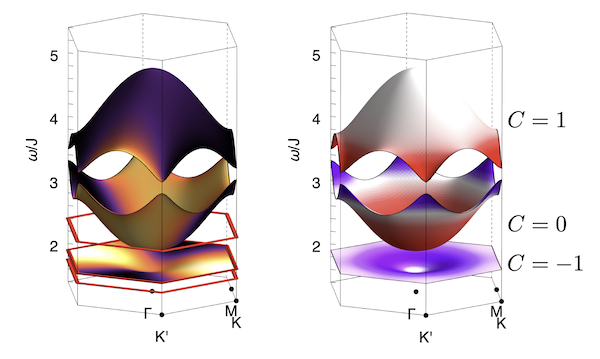
This work is described in the priprint "Pinch points and half moons encode Berry curvature", Han Yan, Andreas Thomasen, Judit Romhányi, Nic Shannon, arXiv:2304.02203.
4. Publications
4.1 Journals
- Matthias Gohlke, Atsushi Iwaki and Chisa Hotta. "Thermal pure matrix product state in two dimensions: Tracking thermal equilibrium from paramagnet down to the Kitaev honeycomb spin liquid state" DOI: 10.21468/SciPostPhys.15.5.206
- Matthias Gohlke, Alberto Corticelli, Roderich Moessner, Paul A. McClarty, and Alexander Mook. "Spurious Symmetry Enhancement and Interaction-Induced Topology in Magnons" DOI:10.1103/PhysRevLett.131.186702
- Aishwarya Chauhan, Atanu Maity, Chunxiao Liu, Jonas Sonnenschein, Francesco Ferrari, and Yasir Iqbal. "Quantum spin liquids on the diamond lattice" DOI:10.1103/PhysRevB.108.134424
- Rico Pohle and Ludovic D. C. Jaubert. "Curie-law crossover in spin liquids" DOI:10.1103/PhysRevB.108.024411
- G. Rakala, D. Mandal, S. Biswas, K. Damle, D. Dhar, and R. Rajesh. "Spontaneous layering and power-law order in the three-dimensional fully-packed hard-plate lattice gas" DOI:10.1103/PhysRevE.107.064137
- D. Mandal, G. Rakala, K. Damle, D. Dhar, and R. Rajesh. "Phases of the hard-plate lattice gas on a three-dimensional cubic lattice" DOI:10.1103/PhysRevE.107.064136
- Yunlong Yu, Chenfeng Cao, Xiang-Bin Wang, Nic Shannon and Robert Joynt. "Solution of SAT Problems with the Adaptive-Bias Quantum Approximate Optimization Algorithm" DOI:10.1103/PhysRevResearch.5.023147
- Rico Pohle, Nic Shannon, and Yukitoshi Motome. "Spin Nematics Meet Spin Liquids: Exotic Quantum Phases in the Spin-1 Bilinear-Biquadratic Model with Kitaev Interactions" DOI:10.1103/PhysRevB.107.L140403
4.2 Books and other one-time publications
Nothing to report
4.3 Oral and Poster Presentations
Invited Talks
- Nic Shannon "Can machines do theoretical physics?” Machine Learning Summer School, OIST, Okianwa (2024.03.15)
- Jiahui Bao "Magnon Spectra of Cuprate Materials beyond Spin Wave Theory" Koushare Theoretical Physics Seminar in Japan, Online (2024.02.14)
- Nic Shannon "Gravitational wave analogues in quantum liquid crystals"Quantum Liquid Crystal Meeting, Tokyo, Japan (2023.12.28)
- Tokuro Shimokawa "Entanglement-based identification: quantum spin liquid state vs. quantum frustrated random singlet state" Illuminating the possibilities: what can ESS contribute to the study of quantum materials?, European Spallation Source (ESS), Lund, Sweden (2023.11.24)
- Snidgh Sabharwal "Witnessing Disorder in a Quantum Spin liquid" Illuminating the possibilities: what can ESS contribute to the study of quantum materials?, Lund, Sweden (2023.11.23)
- Nic Shannon "From franctionalization to fractons and fragmentation: bits and pieces of science coming out of MPI-PKS" Scientific Workshot: 30 years MPI-PKS, Dresden, Germany (2023.09.07)
- Tokuro Shimokawa "Entanglement-based Method for Distinguishing Quantum Spin Liquid and Quantum Frustrated Random Singlet States" 極限宇宙ワークショップ~実験と理論の協奏に向けて:固体物質系から量子・冷却気体系まで, The University of Tokyo, Tokyo, Japan (2023.05.16)
Contributed Talks
- Matthias Gohlke "Thermal pure matrix product state in two dimensions: tracking thermal equilibrium from paramagnet down to the Kitaev spin liquid state" SQAI-NCTS Workshop on Tensor Network and Quantum Embedding, The University of Tokyo, Tokyo, Japan (2024.03.27)
- Tokuro Shimokawa "Multipartite Entanglement at Finite Temperature: A Tool for Distinguishing Random Singlet and Quantum Spin Liquid States" The Physical Society of Japan, 2024 Spring Meeting (Online), Japan (2024.03.20)
- Nic Shannon "Gravitational wave analogues in spin nematics and cold atoms" APS March Meeting, Minneapolis, USA (2024.03.08)
- Jiahui Bao "Magnon Spectra of Cuprate Materials beyond Spin Wave Theory" APS March Meeting, Minneapolis, USA (2024.03.08)
- Snigdh Sabharwal "Witnessing Disorder in a Quantum Spin liquid" The 2nd Young Researchers workshop of the Extreme Universe Collaboration, Shiga, Japan (2024.02.22)
- Pranay Patil "Z_2 spin liquid in Rydberg atom arrays using path integral sampling (QMC)" Highly Frustrated Magnetism 2024, Chennai, India (2024.01.12)
- Matthias Gohlke "Proximate Tomonaga-Luttinger Liquid with Spinon-like Excitations in an Anisotropic Kitaev-Gamma Model" Highly Frustrated Magnetism 2024, Chennai, India (2024.01.09)
- Tokuro Shimokawa "Entanglement-based identification of quantum spin liquid and quantum frustrated random singlet states" Highly frustrated magnetism 2024, Chennai, India (2024.01.08)
- Geet Rakala "Two-dimensional random transverse field Ising model (a numerical SDRG approach)" ExU-YITP Workshop on Condensed Matter Physics and Quantum Information , Yukawa Institute for Theoretical Physics, Kyoto, Japan (2023.09.29)
- Matthias Gohlke "Thermal pure matrix product state in two dimensions: tracking thermal equilibrium from paramagnet down to the Kitaev spin liquid state" ExU-YITP Workshop on Condensed Matter Physics and Quantum Information, Yukawa Institute for Theoretical Physics, Kyoto, Japan (2023.09.29)
- Matthias Gohlke "Thermal pure matrix product state in two dimensions: tracking thermal equilibrium from paramagnet down to the Kitaev spin liquid state" JPS Autumn Meeting 2022, Tohoku University, Sendai, Japan (2023.09.18)
- Tokuro Shimokawa "Entanglement-Based Detection of Quantum Frustrated Random Singlet State in Spin Liquid Candidates" The 9th International Discussion Meeting on Relaxations in Complex Systems, Chiba, Japan (2023.08.14)
- Ananya Samanta "Thermal Expansion Anomalies in Spinels: CdCr2O4 and Beyond" StatPhys 28, The University of Tokyo, Tokyo, Japan (2023.08.11)
- Leilee Chojnacki "Analogues of gravity in the collective excitations of quantum magnets" StatPhys 28, The University of Tokyo, Tokyo, Japan (2023.08.11)
Seminars
- Leilee Chojnacki "Analogues of light and gravity in the collective excitations of quantum magnets" Reuther group, Freie Universitaat Berlin, Germany (2023.12.12)
- Tokuro Shimokawa "Can Quantum Frustrated Random Singlet States and Quantum Spin Liquid States Be Experimentally Distinguished?" University of Hyogo (2023.11.09)
Posters
- Jiahui Bao "Magnon Spectra of Cuprate Materials beyond Spin Wave Theory" SQAI-NCTS Workshop on Tensor Network and Quantum Embedding, The University of Tokyo, Tokyo, Japan (2024.03.27)
- Ayushi Singhania "Emergence of vortex state in S=1 Kitaev-Heisenberg model with single ion anisotropy" SQAI-NCTS Workshop on Tensor Network and Quantum Embedding, The University of Tokyo, Tokyo, Japan (2024.03.27)
- Ayushi Singhania "Emergence of vortex state in S=1 Kitaev-Heisenberg model with single ion anisotropy" Highly Frustrated Magnetism 2024, IIT Madras, Chennai, India (2024.01.11)
- Snigdh Sabharwal "Witnessing Disorder in a Quantum Spin Liquid" Highly Frustrated Magnetism 2024, IIT Madras, Chennai, India (2024.01.11)
- Ananya Samanta "Thermal Expansion Anomalies in Spinels: CdCr2O4 and Beyond" Conference on Fractionalization and Emergent Gauge Fields in Quantum Matter, ICTP, Trieste, Italy (2023.12.07)
- Leilee Chojnacki "Gravitational wave analogues in spin nematics and cold atoms" Conference on Fractionalization and Emergent Gauge Fields in Quantum Matter, ICTP, Trieste, Italy (2023.12.05)
- Leilee Chojnacki "Gravitational wave analogues in spin nematics and cold atoms" QIMG, YITP, Kyoto (2023.09.26)
- Tokuro Shimokawa "Entanglement-Based Identification of Quantum Spin Liquid and Quantum Frustrated Random Singlet States" Statphys 28, Online (2023.08.08)
- Tokuro Shimokawa "Entanglement-Based Detection of Quantum Frustrated Random Singlet State in Spin Liquid Candidates" YIPQS long-term workshop Quantum Information, Quantum Matter and Quantum Gravity, Yukawa Institute for Theoretical Physics, Kyoto University (2023.09.26)
Lecture Series
- Tokuro Shimokawa "Computational Physics" Nihon University, 90 min x 15 classes, (2023.4 to 2023.9)
5. Intellectual Property Rights and Other Specific Achievements
Nothing to report
6. Meetings and Events
6.1 Crystalline phases and devil's staircase in qubit spin ice
- Date: March 21, 2024
- Venue: OIST B503 and zoom
- Speaker: Dr. Karlo Penc (HUN-REN Wigner Research Centre for Physics)
6.2 SCGA for Spin-1 Magnets
- Date: March 18, 2024
- Venue: OIST C700 and zoom
- Speaker: Dr. Kimberly Remund (NYCU National Yang Ming Chiao Tung University)
6.3 CP2 triple-Q state in the SU(3) Kondo lattice model
- Date: March 13, 2024
- Venue: OIST L4E48 and zoom
- Speaker: Prof. Yutaka Akagi (The University of Tokyo)
6.4 Domain-wall skyrmions in chiral magnets
- Date: March 12, 2024
- Venue: OIST C209 and zoom
- Speaker: Dr. Yuki Amari (Keio Univeristy)
6.5 Designing Light in an Artificial Universe
- Date: February 26, 2024
- Venue: OIST C209 and zoom
- Speaker: Prof. Han Yan (The University of Tokyo)
6.6 Adaptive quantum optimization algorithms for ising-like models
- Date: February 15, 2024
- Venue: OIST C210 and zoom
- Speaker: Prof. Robert Joynt (University of Wisconsin-Madison)
6.7 Ground state of the S=1/2 pyrochlore Heisenberg antiferromagnet: A quantum spin liquid emergent from dimensional reduction
- Date: February 13, 2024
- Venue: OIST C210 and zoom
- Speaker: Prof. Rico Pohle (Keio University)
6.8 Education in Quantum Science at the Master’s Degree Level
- Date: February 9, 2024
- Venue: OIST L5D23 and zoom
- Speaker: Prof. Robert Joynt (University of Wisconsin-Madison)
6.9 Quantum reservoir probing of nonequilibrium information propagation in diverse quantum systems
- Date: February 7, 2024
- Venue: OIST C210 and zoom
- Speaker: Mr. Kaito Kobayashi (The University of Tokyo)
6.10 Monte Carlo study on low-temperature phase diagrams of the J1-J2 classical XY kagome antiferromagnet
- Date: December 14, 2023
- Venue: OIST B503 and zoom
- Speaker: Mr. Fumiya Kakizawa (Saitama University)
6.11 Constrained limits of classical frustrated Ising models from tensor networks
- Date: September 5, 2023
- Venue: zoom
- Speaker: Dr. Jeanne Colbois (Université de Toulouse)
6.12 Equivariant Transformer is All You Need
- Date: August 30, 2023
- Venue: OIST B503 and zoom
- Speaker: Prof. Akio Tomiya (International Professional University of Technology)
6.13 Local detection of Majorana zero mode in Kitaev’s chiral spin liquid
- Date: August 29, 2023
- Venue: OIST C210 and zoom
- Speaker: Prof. Masafumi Udagawa (Gakushuin University)
6.14 Disorder effects in the Kitaev-Heisenberg model
- Date: May 23, 2023
- Venue: OIST L4E48 and zoom
- Speaker: Dr. Ayushi Singhania (Institute for Theoretical Solid State Physics)
6.15 Weakly first-order quantum phase transition between Spin Nematic and Valence Bond Crystal Order in a square lattice SU(4) fermionic model
- Date: April 24, 2023
- Venue: OIST C209 and zoom
- Speaker: Dr. Pranay Patil (Max Planck Institute for Physics of Complex Systems)
7. Other
Nothing to report.



